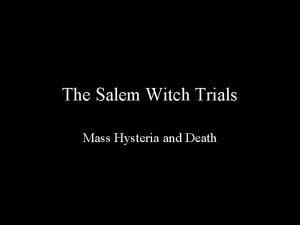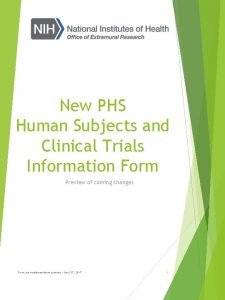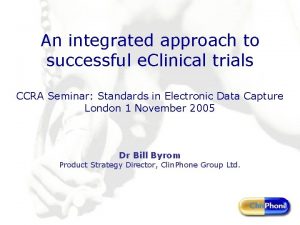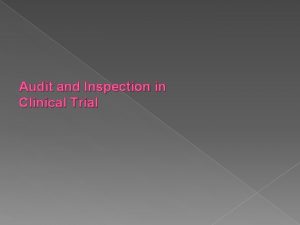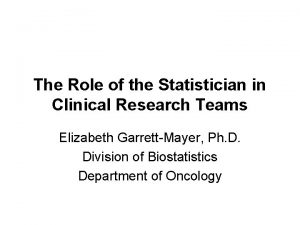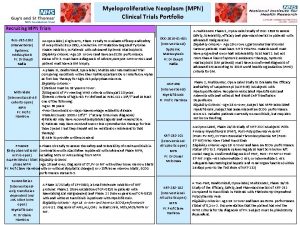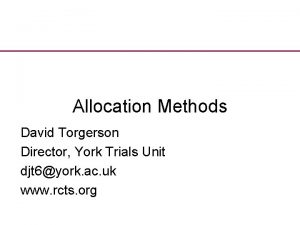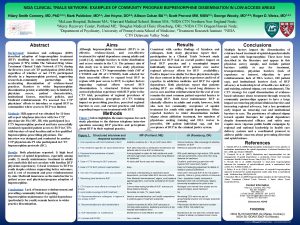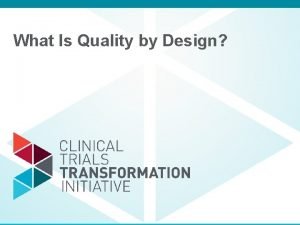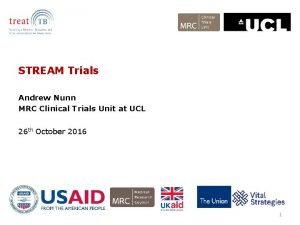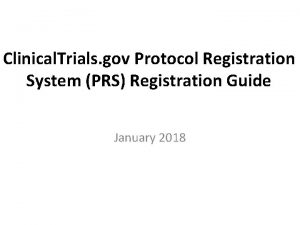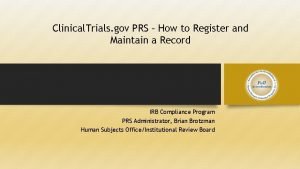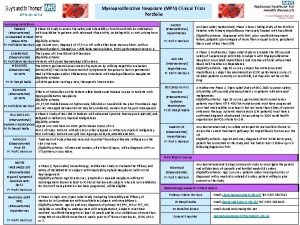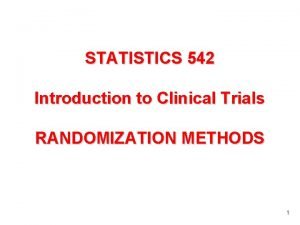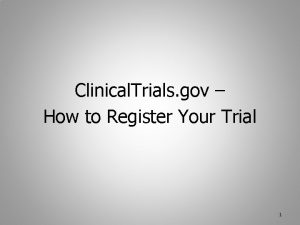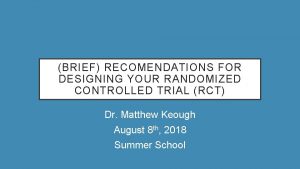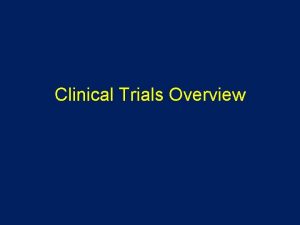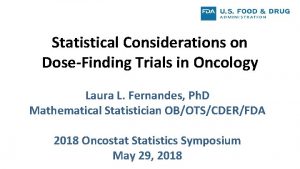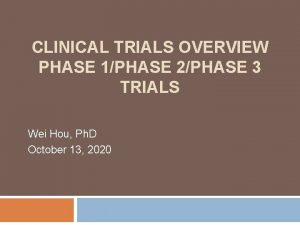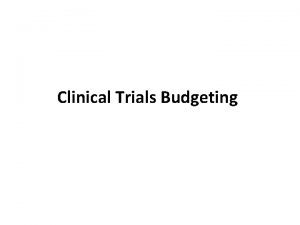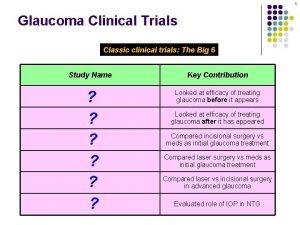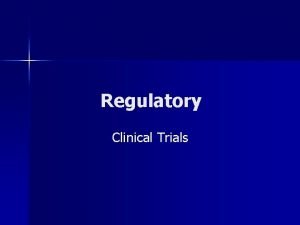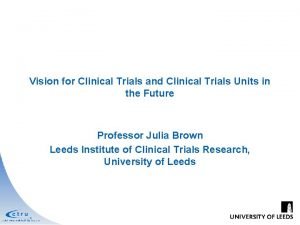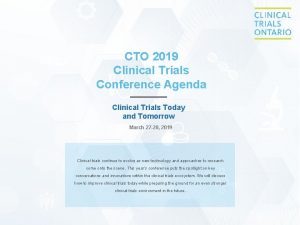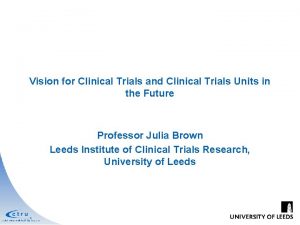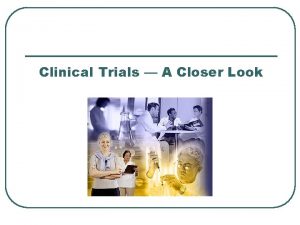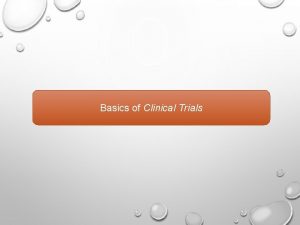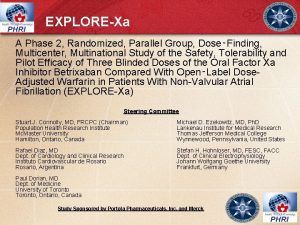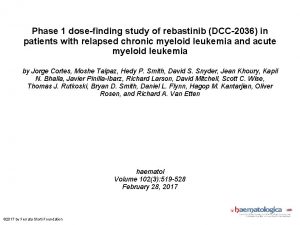NHMRC Clinical Trials Centre Designing DoseFinding Phase I



















- Slides: 19

NHMRC Clinical Trials Centre Designing Dose-Finding Phase I Clinical Trials A/Prof Chee Lee NHMRC Clinical Trials Centre St George Hospital

NHMRC Clinical Trials Centre Top 10 Qs To Be Discussed With Your Statistician 1. What is the objective of the design and what are the appropriate endpoints? 2. How many agents are being escalated? 3. What should be the target rate of DLT? 4. What should be the DLT assessment window? 5. How should DLT be defined? 6. How many patients do I need? 7. How many patients should be included in each cohort? 8. How many doses should be evaluated? 9. Which patients are considered evaluable for toxicity? 10. How long will the trial take and when should the trial be stopped? Lee et al 2021, JCO Precis Oncol 5: 317 -324

NHMRC Clinical Trials Centre What is the objective of the design and what are the appropriate endpoints? • Traditional cytotoxic phase I trial premise: ↑ dose ≈ ↑ toxicity ≈ ↑ efficacy • Molecularly targeted agents or immunotherapy agents: ↑ dose ≠ ↑ efficacy • Dose that properly balances the trade-off between specified toxicity threshold and activity • Other considerations: • homogeneous patient population • lag time exists between when the safety and efficacy endpoints • robust surrogate measures of efficacy

NHMRC Clinical Trials Centre How many agents are being escalated? • No of agents being evaluated simultaneously • ordering of expected probability of DLT • Only one agent is being dose-escalated and the dose of other agent(s) is fixed • Multiple doses of different agents • Dose escalation for all • Some dose escalation, some dose de-escalation • DLT probability for different combination will be different • Model-based designs give the flexibility in the starting of dose and the number of patients per cohort to be used for dose-escalation

NHMRC Clinical Trials Centre What should be the target rate of DLT? • Target DLT rate = acceptable proportion of patients that defines the MTD • Ability to specify a target DLT rate helps to characterise optimal dose • Model-based approaches more flexibility, advantageous in tailoring design according to the class of agent or agents being studied

NHMRC Clinical Trials Centre • What should be the DLT assessment window? Traditional chemotherapy trials, DLT is being assessed during the first treatment cycle (e. g. 28 days) • Might not be suitable for other agents with late onset toxicity, e. g. immunotherapy, radiation therapy • Interest in accounting for DLTs observed beyond cycle 1 in dose allocation and in refinement of the RP 2 D • Time-to-event CRM use data from partially observed for DLT in the estimation of toxicity probabilities, weighting each entered patient by a portion of the full DLT observation window according to follow-up period

NHMRC Clinical Trials Centre How should DLT be defined? • Traditional cytotoxic phase I trial: • grade ≥ 3 non-haematological AEs within DLT assessment window • grade ≥ 4 haematological AEs within DLT assessment window • Novel agents can lead to intolerable moderate grade 2 toxicities (e. g. chronic rash, diarrhoea etc from TKI) • Model-based designs that allow for the specification of different tolerance levels for various gradations of AEs e. g. MTD can be defined as the dose that satisfies not only a target DLT rate of 25% but also a target grade ≥ 2 AE rate of 35% • Composite score of toxicity types and grades e. g. kinase inhibitor weighted toxicity score Carbini et al Clin Cancer Res 2018; 24: 4968 -4975

NHMRC Clinical Trials Centre How many patients per cohort? • Traditional design has fixed cohort size e. g. 3+3 design • Model based approach has more flexibility • Deviation from cohort size, if allowed, needs to be specified (e. g. trial with multiple simultaneously recruiting cohorts, a minimum of one participant per cohort must be assessed until the first DLT is observed and then at least three additional participants per cohort are required). • Also need to specify minimum window between cohorts, particularly for designs that allow dose escalation on the basis of partially observed data

NHMRC Clinical Trials Centre How many doses should be evaluated? • Starting dose is usually one tenth of the LD 10 (i. e. , the dose that is lethal to 10% of animals) • Dose levels should be sufficiently different that they are expected to produce different probabilities of AE rates. • Number and range of dose levels are often based on preclinical studies and/or previous studies of similar agents in the class or various formulations of the drug • Implications for the design and the sample size

NHMRC Clinical Trials Centre Which patients are considered evaluable for toxicity? • Protocol needs to define who is evaluable for toxicity • Patients did not complete treatment within DLT window due to disease progression/death – should these patients be replaced? • DLT assessment window needs to be considered in the context of known PFS • If median PFS ≈ DLT assessment window, designs (e. g. TITECRM) to use partial information from these patients and reduce the number of non-evaluable patients.

NHMRC Clinical Trials Centre How long will the trial take and when should the trial be stopped? • The expected accrual rate • Duration of DLT evaluation window • Cohort sample size for each dose • $$$ • Criteria for stopping are protocol defined • Achieved the prespecified target sample size • Designs to allow ongoing recruitment for dose-escalation vs doseexpansion

NHMRC Clinical Trials Centre Rule-based approach Traditional 3+3 design

NHMRC Clinical Trials Centre Standard 3+3 design S. Percy Ivy et al. Clin Cancer Res 2010; 16: 1726 -1736

NHMRC Clinical Trials Centre Different variations Accelerated titration design • Design 1 – similar to 3+3 design with 40% dose increment per cohort • Design 2 - dose increment of 40%, but there is only 1 patient at each dose level. If 1 DLT during cycle 1, the dose escalation in the accelerated phase will be terminated, dose escalation will revert back to Design 1 • Design 3 – dose increment of 100% between individual patient cohorts. If 1 DLT during cycle 1, the dose escalation will revert to Design 1. • Design 4 – dose increment of 100% between individual patient cohorts. If 1 DLT during any cycle, the dose escalation Simon et al J Natl Cancer Inst 1997, 89(15), 1138 -1147. will revert to Design 1.

NHMRC Clinical Trials Centre Model based design - continual reassessment method (CRM) Statistical model to actively seek a dose level by using toxicity data from all enrolled patients. Steps involved: Pre-specified probability DLT 1. Pre-specify target DLT rate 2. Pre-specify number of patients per cohort 3. Develop a mathematical model of the probability of experiencing a DLT is a function of dose level 4. Determine stopping rule ≈ sample size

NHMRC Clinical Trials Centre Implementation of Bayesian model based design specify prior distribution to characterize the shape of curve Pre-specify target DLT rate refinement of prior distribution based on 1 st patient with DLT – posterior distribution Further refinement of posterior distribution based on next patient without DLT

NHMRC Clinical Trials Centre Extension of CRM – TITE BOIN design 1 DLT in 4 th patient at 165 days with incomplete follow-up for 5 th and 6 th patients Multiple DLTs at DL 3, deescalate 2 further DLTs at DL 2 • Real-time dose assignment decisions for new patients while some enrolled patients’ toxicity data are still pending • Address issues related to late-onset toxicity, rapid accrual and insufficient observation time for toxicity to develop Patient 15 with DLT, trial suspended to allow more followup time to evaluate at DL 2 Dose deescalation in patients 7 -9 First cohort with no DLT at 60 days Ying Yuan et al. Clin Cancer Res 2018; 24: 4921 -4930

NHMRC Clinical Trials Centre Extension of CRM Ti. TECRM Time-to-Event CRM to account for late-onset toxicities and to allow shorter trial duration The dose allocated for participant 5, at the current time point, is decided by accounting for all of the available data, which includes the toxicity status and weights of participants 1– 4

NHMRC Clinical Trials Centre Conclusion • Traditional rule based designs were developed based on chemotherapy • These designs might be less appropriate for molecularly targeted therapies and immunotherapies • The series of questions help to address the desired research objectives of your phase 1 trials • You need to consult with a statistician in designing your trial and should not apply an “off-the-shelf” method with simple decision processes
 Nhmrc emerging leadership fellow
Nhmrc emerging leadership fellow Clinical hysteria salem witch trials
Clinical hysteria salem witch trials Lej hub customs dhl
Lej hub customs dhl Phs human subjects and clinical trials information
Phs human subjects and clinical trials information Iwr clinical trial
Iwr clinical trial Difference between inspection and audit
Difference between inspection and audit Clinical research statistician
Clinical research statistician Readyset ohsu
Readyset ohsu Mpn clinical trials
Mpn clinical trials York trials unit
York trials unit Nida clinical trial network
Nida clinical trial network Clinical trials quality by design
Clinical trials quality by design Andrew nunn
Andrew nunn Clinical trial prs
Clinical trial prs Prs administrator
Prs administrator Site initiation visit agenda
Site initiation visit agenda Mpn clinical trials
Mpn clinical trials Randomization
Randomization Clinical trials.gov login
Clinical trials.gov login Clinical trials
Clinical trials

